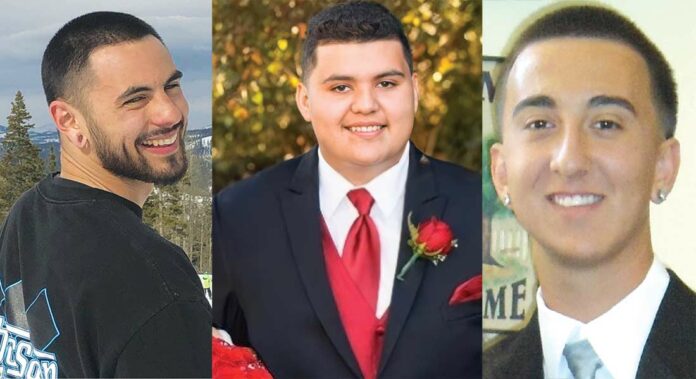
Gilroy resident Fernando Sanchez had just gotten out of school and was hanging out with some friends one afternoon last March when the group decided to recreationally consume pills they thought were the anti-anxiety medication Xanax.
The teens had purchased the drug from a local small-time street dealer, according to Fernando’s mother, Lisa Marquez. Fernando had been at his friend’s house throughout the afternoon and evening. His mother was awoken in the middle of the night by Gilroy Police officers banging on her door to inform her that her 17-year-old son had been transported to a nearby hospital with symptoms of a drug overdose.
Marquez immediately rushed to the hospital, where she was told that Fernando had died. Paramedics tried to revive him by administering Narcan, a medication that can reverse the effects of opioid poisoning.
“Everything went black,” Marquez said in a recent interview. “I can’t believe this happened.”
The drug that Fernando consumed was not Xanax, and the pill contained the potent opioid fentanyl—which is up to 100 times stronger than morphine—without his knowledge. Fernando died March 26, 2020, of accidental “combined fentanyl and Tramadol toxicity,” according to the Santa Clara County Medical Examiner-Coroner’s Office.
Fernando was an eleventh-grader at Gateway School in Gilroy when he died, his mother said. He was “a normal kid” in advanced classes. His favorite subject was reading, and he enjoyed listening to music. “He was funny, and always had something quick to say,” Marquez added.
Jacob Vasquez was 24 years old when he went to bed one night at his family’s west Gilroy home while visiting for Thanksgiving weekend last year. He had also consumed a pill that he thought was Xanax, acquired from a street dealer, according to his mother, Geralyn Vasquez.
But that pill also contained fentanyl, which has been connected to thousands of accidental deaths across the nation. Instead of waking him up for breakfast the next morning, Vasquez’ family found Jacob dead in his bedroom Nov. 28, his mother said.
His toxicity report from the medical examiner’s office said his blood contained not only fentanyl, but also an analog of the drug known as 4-anpp, as well as a generic form of Xanax. Vasquez’ manner of death was also ruled an accident.
Jacob Vasquez had struggled with ADHD and—like many young people his age—had “self medicated” in recent years, Geralyn said. A death like his could have happened to anyone.
“There are no words to describe the grief,” Geralyn Vasquez said. “Now our lives are different forever. If we can spare just one family from having to go through this horrible nightmare… A mistake shouldn’t end your life.”
Another Gilroy resident, Joseph David Saavedra, died under similar circumstances Feb. 5, 2021. The 26-year-old Gilroy High School alumnus had recently moved back to the area from Nevada, and was “on the right track,” said his mother, Eleanor Saavedra.
Joseph died after ingesting drugs he acquired from a local dealer that were also laced with fentanyl, unbeknownst to him. His parents found him at the mobile home where he was living, after he hadn’t responded to numerous texts, Eleanor said.
“He was taking risks, but I don’t think in my heart he was expecting that to happen,” she said. “That’s not who he was.”
She added, “He was a wonderful kid” who enjoyed annual camping and snow trips with family and friends, and had a pet pit bull he had raised.
Geralyn Vasquez, Lisa Marquez and Eleanor Saavedra later connected through social media and mutual contacts as they attempted to learn more about the fentanyl crisis—which they were previously unaware of—and why it has taken the lives of so many young people like their sons. They reached out to this newspaper in an effort to raise awareness of the drug, which authorities say has become pervasive in illicit drugs in Santa Clara County.
“It is important to bring awareness because there is a lot of this happening,” Saavedra said. “These kids came from good homes.”
Part of their goal is to reduce the stigma surrounding deaths by accidental fentanyl overdose, which is more accurately described as “poisoning,” Vasquez noted.
Fentanyl overdose or poisoning deaths have skyrocketed throughout Santa Clara County since 2019. As of Aug. 31, there have been 49 confirmed fentanyl overdose deaths in Santa Clara County in 2021, with authorities still processing numerous cases that are not yet confirmed.
In 2020, there were 88 fentanyl deaths in the county, and 27 in 2019, according to the Santa Clara County District Attorney’s Office.
In August, county authorities reported a “wave” of seven fentanyl deaths, chiefly among the homeless in San Jose. A Morgan Hill juvenile died of a suspected fentanyl overdose on Aug. 3, according to authorities. Inmates at the county jail have overdosed on the drug.
According to the U.S. Centers for Disease Control and Prevention, most recent cases of fentanyl-related harm, overdose, and death in the U.S. are linked to illegally made fentanyl. Most of the recent local fentanyl overdose fatalities occurred after the victim ingested fake pills they thought were less dangerous prescription drugs—such as Xanax or oxycodone—that were laced with fentanyl. More recent cases have seen drugs like methamphetamine or ecstasy containing fentanyl.
The DA’s Office helped create a countywide fentanyl task force, which is attempting to combat the fentanyl problem not only with arrests and prosecutions, but also behavioral health services, access to treatment options and public outreach, explained Brian Buckelew, formerly the Supervising Deputy DA for the office’s Narcotics Unit. The task force includes the coroner-medical examiner, whose death examinations are critical in ongoing investigations.
Buckelew said fentanyl is at the “top of the list” of the DA’s wide range of public safety concerns.
“We are doing all we can to get the word out about fentanyl deaths. Juvenile deaths are reviewed. The crime lab tests all drugs (confiscated by law enforcement) in the county to look for patterns,” Buckelew said in September, before he left the DA’s office for an appointment as a Superior Court judge.
The DA’s office recently began a public outreach campaign informing the public to “expect fentanyl” in any illicit drugs they purchase off the streets. Users and their households are encouraged to have Narcan on hand in case of emergencies. The nasal spray medication is available to take home over the counter at most pharmacies, and at county public health facilities.
Marquez, Saavedra and Vasquez think their sons purchased their fatal drugs from the same dealer, and would like to see that suspect prosecuted for homicide. Gilroy Police and the Sheriff’s Office have investigated all three incidents, but the suspect has not been charged with a homicide-related crime, according to the women.
Buckelew said it is challenging to prosecute a drug dealer for murder because many factors are difficult to prove—“namely, if the seller knew the drug contained fentanyl and the recipient of the drug did not,” he said.
A growing challenge with drug possession or trafficking prosecutions is the fact that fake drugs are often sold on social media, specifically Snapchat, according to authorities.
The mothers’ efforts to raise awareness have borne some fruit in recent months. They continue to reach out to local, regional and state representatives, and have organized small town hall style meetings.
Vasquez recently helped start the Jacob Vasquez Memorial Scholarship at Mount Madonna High School, where her son graduated. The scholarship is for “kids who might be at risk, who might fall through the cracks, for them to get certified at a trade school and come out and support themselves,” Geralyn said.
Marquez recently met with Gilroy Councilmember Rebeca Armendariz and Congressman Jimmy Panetta to discuss the local fentanyl problem. Armendariz said she plans to advocate for more resources from the city for efforts like increased availability of Narcan and more outreach.
“Fentanyl is more of a poison than a drug,” Armendariz said. “People have died unintentionally, and it’s something that we need a lot more resources to educate young people and parents and community members.”
She added, “Fentanyl isn’t limited to any certain socioeconomic group. It is killing people in all different economic classes and racial and cultural backgrounds, and ages.”







